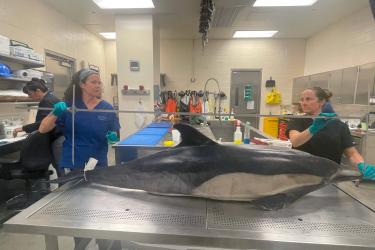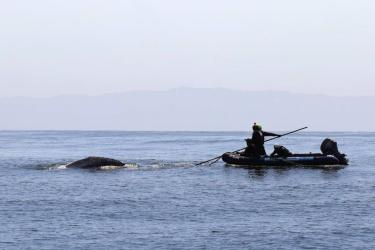We are crawling on a sandy beach on San Miguel Island off the coast of California, making sure the wind is not at our backs. Human scent would likely spook the sleeping California sea lions in front of us—about 300 of them. One is our target. Twenty feet to our left an elephant seal watches us with open eyes, head up and ready to charge to defend her pup if the team gets too close. We move away to respect her space. We carry large, strong nets, and we remain alert and ready to respond if our target moves. The team leader halts and we get ready, watching her fingers signal a countdown – 3.…2…1…GO!
We jump up and sprint towards the target, which startles all the sea lions and causes a chaotic run towards safety in the ocean. They are surprisingly fast, even on land! The sea lions look similar, but the target animal still stands out: the 1-inch wide gash encircling its neck with the plastic gillnet in the middle of it is hard to miss. Can we catch it before it reaches the water?
Marine mammal entanglements in fishing gear such as gillnets and fishing line, and marine debris, including packing straps, can cause serious injuries. It also kills hundreds to thousands of marine mammals every year. Young animals are particularly vulnerable to injuries from entanglements. As they grow, the netting gets tighter and tighter. It slices through fur, skin, blubber, muscle, and eventually bone. Incredibly, some sea lions suffer from painful and debilitating entanglements for years.
While this certainly harms the entangled animals, what does it mean for the species in the long term? While NOAA Fisheries has gathered some information through stock assessments, many important questions remain unanswered:
- How many entanglements occur each year?
- Are there hotspots where they happen frequently?
- Are there peak periods?
- Has the problem worsened over time?
- To what extent do entanglements impact marine mammal health?
- How do animals recover after the entangling material is removed?
- Are certain groups of animals at higher risk?
We need to know more about marine mammal entanglements to guide conservation and mitigation efforts. We want to answer those questions, while also actively disentangling sea lions. It’s part of a project led by The Marine Mammal Center in Sausalito, California and NOAA Fisheries’ Marine Mammal Laboratory in Seattle, Washington. The work is supported by a John H. Prescott Marine Mammal Rescue Assistance Grant from NOAA Fisheries Marine Mammal Health and Stranding Response Program.
Around 45 percent of the California sea lion population breeds on San Miguel Island. The island is part of Channel Islands National Park off the coast of Southern California. The Park is surrounded by the Channel Islands National Marine Sanctuary. It is a crucial refuge for seals and sea lions, and is home to many other unique animals including the endemic Channel Islands fox. You can find California sea lions sleeping, breeding, and pupping there alongside northern elephant seals, northern fur seals, Pacific harbor seals, threatened Guadalupe fur seals, and Steller sea lions.
Since the 1970s, the California sea lions on the island have been the focus of a long-term research program led by NOAA Fisheries. It monitors changes in population size, health, condition, and survival, providing important insights for conservation. For instance, the research has revealed how changes in oceanographic conditions affect food availability and survival. For the past decade the team has removed entangling gear from sea lions and documented the cause of the entanglement. This motivated a larger project aimed specifically at understanding how entanglement affects the health and population of California sea lions.





